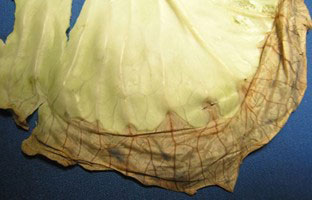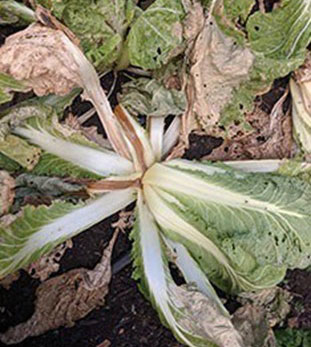Arkansas Plant Health Clinic Disease Notes
Contact
Plant Diagnostician
Phone: (479) 575-2727
Email: ssmith@uada.edu
Jason Pavel
Diagnostician
Phone: (479) 575-7257
Email: jpavel@uada.edu
University of Arkansas
Division of Agriculture
Cralley Warren Building
Room 16
2601 N. Young Ave.
Fayetteville, AR 72704
Cabbage Black Rot
Sherrie Smith and Jason Pavel
September 12, 2022
Plant Health Clinic Disease Note: Issue 29

Black rot caused by Xanthomonas campestris pv. campestris is one of the most damaging diseases of crucifers wherever they are grown. Susceptible hosts include broccoli, Brussels sprouts, cabbage, cauliflower, kale, rutabaga, and turnip, as well as weeds in the cruciferous family such as shepherd’s purse and wild mustard. Yield and quality losses may be high when environmental conditions are conducive for disease development. On seedlings, cotyledons may turn black and drop off. Lesions appear on leaves as yellow, V- shaped spots along the leaf edge, with the base of the V usually directed along a vein. As the lesions expand, the tissue wilts and becomes necrotic. The infection may move up or down the petiole and spread through the stem into the roots. The veins of infected leaves, stems, petioles, and roots become black as the bacterium multiplies and shuts off the flow of nutrients to plant parts. When affected stems are cut crosswise, the vascular ring appears black. Yellow bacterial ooze may exude from cut tissues.
The use of clean seed is important in preventing the disease. Seedling rates should
not be too high as the dense foliage aids in disease development.
Sprinkler irrigation should be avoided. Fields should only be worked when the foliage
is dry. Transplants or seed should not be grown in a spot that has been in crucifers
the last 3 years. Plants with visible symptoms should be pulled up and removed from
the vicinity of the field. Deep plowing helps break down crop residue faster and should
be practiced where practical.

Cabbage Black Rot-Xanthomonas campestris pv. campestris. (Photo by Alyssa Hughes, Arkansas Grower.)
Takeaways:
- Avoid overhead irrigation.
- Practice a three-year crop rotation away from crucifers.
- Remove infected plants.
- Deep plow to bury bacterial infected debris.
Follow us on Facebook!
This work is supported by the Crop Protection and Pest Management Program [grant no. 2017-70006- 27279/project accession no. 1013890] from the USDA National Institute of Food and Agriculture.